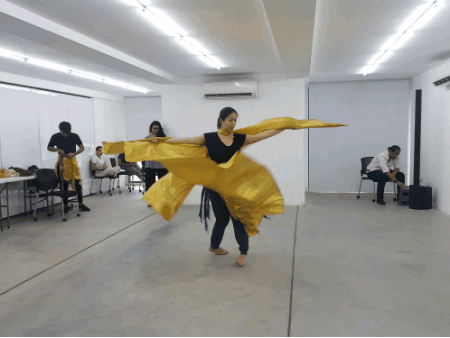This book by Paul Jackson will change the way you view the plain paper. You can click here to view more techniques. The children look at some examples of paper to form and they did a group challenge to make the most out of cartridge papers. With simple material, they can even extend their learning at home. In subsequent weeks, the children were given decorative edge scissors and coloured papers. Their task is to imagine that they were being shrunk to thumb size and they have to design a play space made of papers. They were encouraged to manipulate the papers into forms and we had discussion about the different areas of play spaces using preposition.

Tabs under construction!
Friday, March 2, 2018
Friday, February 23, 2018
Art Class: Collaboration VS Cooperation
How do you collaborate with non-art teachers? In my previous school, there was a teacher who wanted to collaborate with the Art department (technically there was only me then) to celebrate National Day. She wanted the whole school to receive an identical SG flag template and fill in colour. The fact that you are using art materials such as colour pencils or oil pastels doesn't mean it is art. Another point that I have observed is that the term collaboration is used quite loosely.
For example, last year, I had the children to create this underwater theme "mural" towards the end of the year. We read the book You Be You by Linda Kranz and everyone created a self portrait in the form of a fish. I had the concept and I put up everyone's work. So, in a way, this was mostly cooperation because the children work on their own fish but they could draw their own ideas. Yes, it was tedious and time consuming to put up the children's work but it wasn't a complex task. Whereas in collaborating work, the outcome is to work together to solve an open-ended, complex task.
I was glad with the process and outcome of this year's collaboration with non-art teachers. The children created post-it mural of 百福图 (Hundred Fu Painting). The Chinese language teachers and I had a discussion before we decided on using pictogram as a springboard in the art lesson. The main idea about making meaning out of Chinese characters is here.
To read more about the difference between collaboration and cooperation, please click here and here.
For example, last year, I had the children to create this underwater theme "mural" towards the end of the year. We read the book You Be You by Linda Kranz and everyone created a self portrait in the form of a fish. I had the concept and I put up everyone's work. So, in a way, this was mostly cooperation because the children work on their own fish but they could draw their own ideas. Yes, it was tedious and time consuming to put up the children's work but it wasn't a complex task. Whereas in collaborating work, the outcome is to work together to solve an open-ended, complex task.
I was glad with the process and outcome of this year's collaboration with non-art teachers. The children created post-it mural of 百福图 (Hundred Fu Painting). The Chinese language teachers and I had a discussion before we decided on using pictogram as a springboard in the art lesson. The main idea about making meaning out of Chinese characters is here.
To read more about the difference between collaboration and cooperation, please click here and here.
Friday, February 16, 2018
Art Class: Finding Balance (Part II)
The P1s children learnt about painting routine and off they go to practise. They were only given black paint to to ensure they master the routine and not be too overwhelmed by the instructions. They played with fingerpaint on one side of a folded paper and cover the other side down by giving the back of the paper a good massage. Next, they peeled open the paper and they get the print. We talked about balance and symmetry in an artwork AND since I have a girl who wrote her name and got a mirror-image print, we spoke about letters, numbers and invertion. I challenged them to write their name on a paper at home then stand in front of the mirror and tell me their discovery the following week.
Labels:
balance,
primaryone,
printmaking,
symmetry
Thursday, February 8, 2018
Artventures: To Artground
My colleagues and I visited Artground for an art educator's learning journey. We saw spaces for triannual installation which children could enjoy by engaging their bodies. A few dancers giving us a teaser of what the children would experience in their drama workshop. Then we were divided into two groups with each playing the role of monkeys and kangaroos. They even had an outdoor garden and children who signed up for this workshop would learn about the environment, handle earthworms, its compost and do coffee painting.
Labels:
artventures,
learningjourney
Friday, February 2, 2018
Art Class: Patterns Around Us
In the lower primary Mathematics syllabus, the children have learnt about shapes and angles in the Geometry sub-strand. Revisiting these concepts about Patterns meant that lesson has to be applicable. The children looked for Patterns around the canteen. They had to spot for repeated shapes, lines and colours by sketching them. Next, we played a game in class where an image of a close up pattern of object is shown and they had to guess the object. The children also used DIY Tangrams and combine their pieces to make a bigger image.
 |
| These circular plastics were the byproducts of their school files :D |
 |
| Photo credit: Ms Candice |
Labels:
artclass,
patterns,
primarythree,
tangrams
Subscribe to:
Comments (Atom)



















































